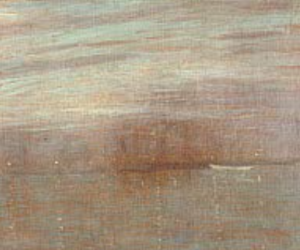Paul Fordyce Maitland (1863-1909), Grey Autumn Day, Chelsea (n.d.)
Paul Fordyce Maitland studied under painter Theodore Roussel, who was in turn good friends with artist James McNeill Whistler. Both men influenced Maitland greatly, and Maitland soon became associated with their circle of artists. Important characteristics of their works include both consistency and harmony in color choice and picture as a whole, balancing color with line in such a way that the painting is tied together in an aesthetically pleasing manner, and an emphasis on nature and landscapes.
Above is a reenactment of Whistler’s reading of his famous “Ten O’Clock” lecture about his artistic philosophy and the role nature plays in his work. The excerpt below is taken from the 10:57 – 12:03 mark.
“Nature contains the elements, in colour and form, of all pictures, as the keyboard contains the notes of all music.
But the artist is born to pick, and choose, and group with science, these elements, that the result may be beautiful—as the musician gathers his notes, and forms his chords, until he bring forth from chaos glorious harmony.
To say to the painter, that Nature is to be taken as she is, is to say to the player, that he may sit on the piano.
That Nature is always right, is an assertion, artistically, as untrue, as it is one whose truth is universally taken for granted – Nature is very rarely right, to such an extent even, that it might almost be said that Nature is usually wrong – that is to say – the condition of things that shall bring about the perfection of harmony worthy a picture, is rare, and not common at all.”
– Whistler’s “Ten O’Clock Lecture” (20 Feb. 1885)
“Man knows the fear of mystery everywhere,
And peeps, with trembling glances, overhead.
The heaven above? A strangling cavern wall;
The lighted ceiling of a music-hall
Where every actor treads a bloody soil-
The hermit’s hope; the terror of the sot;
The sky: the black lid of the mighty pot
Where the vast human generations boil!”
– “The Sky” by Charles Baudelaire, a poet whose work greatly influenced the art of Maitland’s circle (1919)
Sea Drift by Frederick Delius is a tone poem, or a composition meant to bring to life the content of a poem or literary work. This piece in particular is based on “Out of the Cradle Endlessly Rocking” by Walt Whitman, which is primarily about loss, grief, and the power of death. Both the composition and the poem also contain an undertone of the role nature plays in the dark inescapability of these elements, which is hinted at in Grey Autumn Day, Chelsea as well. Below is an excerpt from the poem that illustrates these specific ideas.
“That is the fluttering, the fluttering of the spray,
Those are the shadows of leaves.
O brown halo in the sky near the moon, drooping upon the sea!
O troubled reflection in the sea!
O throat! O throbbing heart!
And I singing uselessly, uselessly all the night.”
– From “Out of the Cradle Endlessly Rocking” by Walt Whitman
Categories: Impressionism, The Mundane, Nature, War



